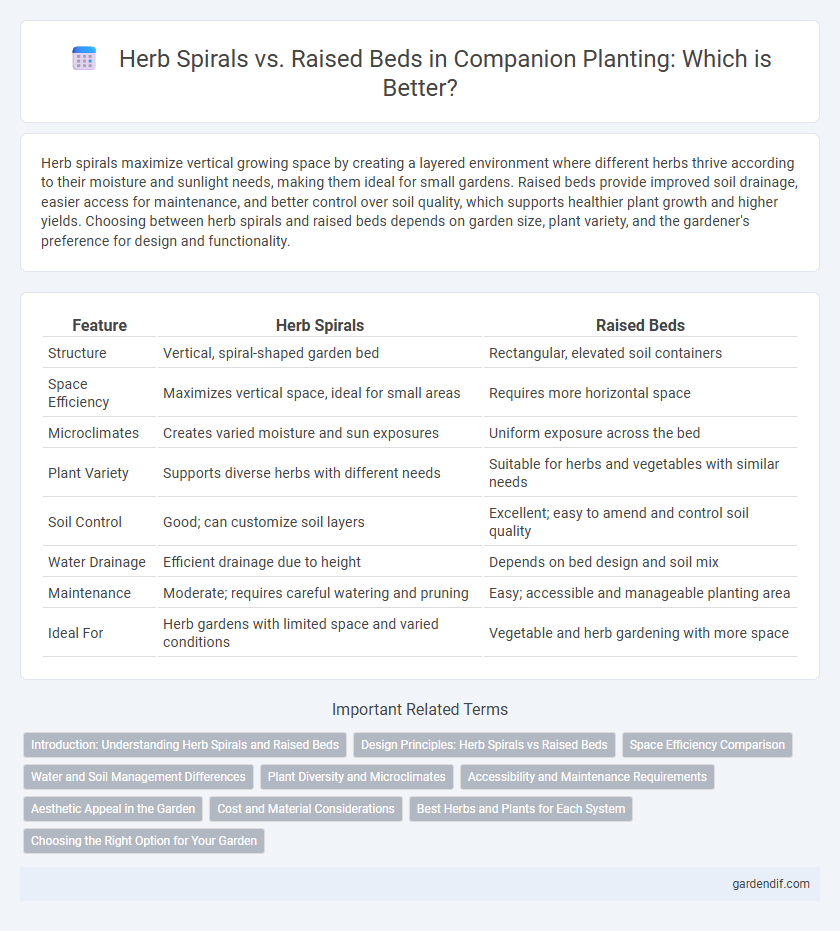
Herb spirals vs Raised beds Illustration
Herb spirals maximize vertical growing space by creating a layered environment where different herbs thrive according to their moisture and sunlight needs, making them ideal for small gardens. Raised beds provide improved soil drainage, easier access for maintenance, and better control over soil quality, which supports healthier plant growth and higher yields. Choosing between herb spirals and raised beds depends on garden size, plant variety, and the gardener's preference for design and functionality.
Table of Comparison
| Feature | Herb Spirals | Raised Beds |
|---|---|---|
| Structure | Vertical, spiral-shaped garden bed | Rectangular, elevated soil containers |
| Space Efficiency | Maximizes vertical space, ideal for small areas | Requires more horizontal space |
| Microclimates | Creates varied moisture and sun exposures | Uniform exposure across the bed |
| Plant Variety | Supports diverse herbs with different needs | Suitable for herbs and vegetables with similar needs |
| Soil Control | Good; can customize soil layers | Excellent; easy to amend and control soil quality |
| Water Drainage | Efficient drainage due to height | Depends on bed design and soil mix |
| Maintenance | Moderate; requires careful watering and pruning | Easy; accessible and manageable planting area |
| Ideal For | Herb gardens with limited space and varied conditions | Vegetable and herb gardening with more space |
Introduction: Understanding Herb Spirals and Raised Beds
Herb spirals and raised beds are innovative gardening structures designed to maximize space and improve plant health. Herb spirals utilize vertical, spiral-shaped mounds to create microclimates for various herbs, enhancing accessibility and water efficiency. Raised beds elevate soil above ground level, promoting better drainage and root growth while reducing soil compaction and weed pressure.
Design Principles: Herb Spirals vs Raised Beds
Herb spirals maximize vertical space by incorporating a spiral-shaped design that creates diverse microclimates for varied plant needs, promoting efficient water drainage and sunlight exposure. Raised beds offer uniform soil depth and improved accessibility, facilitating controlled soil quality and easier pest management for companion planting. Both designs enhance companion planting success by optimizing plant interactions and resource use, but herb spirals emphasize spatial efficiency while raised beds prioritize ease of maintenance.
Space Efficiency Comparison
Herb spirals maximize vertical and horizontal growing space by stacking plants in a compact, tiered design, allowing diverse herbs with varying water and sunlight needs to thrive in a small footprint. Raised beds offer controlled soil conditions and accessibility but require more ground area, making them less space-efficient for intensive herb gardening. For gardeners prioritizing space conservation, herb spirals provide a denser, multi-level planting solution that optimizes microclimates within limited garden areas.
Water and Soil Management Differences
Herb spirals naturally optimize water retention by concentrating moisture at the base while allowing excess to drain downwards, reducing irrigation needs and enhancing soil aeration. Raised beds provide controlled soil conditions with improved drainage and easier amendment application but may require more frequent watering due to elevated exposure. Both methods support efficient soil management, yet herb spirals leverage a vertical design for water conservation, whereas raised beds prioritize soil structure and nutrient control.
Plant Diversity and Microclimates
Herb spirals create vertical microclimates through their tiered structure, supporting diverse plant species with varying water, sunlight, and soil needs in a compact space. Raised beds allow precise soil control and drainage management, fostering plant diversity by tailoring conditions for specific herbs or companion plants. Both methods enhance biodiversity, but herb spirals maximize vertical space and microenvironment variation more effectively than flat raised beds.
Accessibility and Maintenance Requirements
Herb spirals offer vertical, compact designs that enhance accessibility by placing plants at varied heights, reducing bending and stretching during maintenance. Raised beds provide flat, elevated surfaces that simplify soil management and pest control while allowing wheelchair access and ease of harvesting. Both systems minimize weed growth but raised beds generally require less frequent watering due to better soil moisture retention.
Aesthetic Appeal in the Garden
Herb spirals create a visually striking centerpiece with their spiral design, showcasing a diverse range of herb heights and textures that enhance garden aesthetics. Raised beds offer structured, clean lines and can be customized with attractive materials for a modern or rustic look. Both methods promote organized planting but herb spirals provide a more naturalistic, artistic appeal compared to the geometric precision of raised beds.
Cost and Material Considerations
Herb spirals typically require more initial materials such as stones, bricks, or wood to construct the spiral structure, potentially increasing upfront costs compared to raised beds, which often use simpler wood or metal frames. Raised beds generally offer more straightforward material options that can be sourced affordably or even repurposed, making them cost-effective for beginners. Cost efficiency depends on available resources and design complexity, with herb spirals emphasizing vertical space and microclimates while raised beds prioritize accessibility and ease of construction.
Best Herbs and Plants for Each System
Herb spirals excel with water-loving herbs like mint, basil, and parsley, benefiting from their vertical microclimates that conserve moisture and maximize space. Raised beds suit sun-loving plants such as thyme, rosemary, and lavender, offering well-drained soil conditions and easier pest control. Selecting the right herbs for each system enhances growth, harvest quality, and companion planting success.
Choosing the Right Option for Your Garden
Herb spirals maximize vertical growing space and create microclimates for diverse herbs, promoting companion planting and water efficiency. Raised beds improve soil drainage, reduce soil compaction, and provide easier access, making them ideal for larger vegetable or herb gardens. Selecting between herb spirals and raised beds depends on garden size, plant variety, and desired maintenance levels for optimal growth and productivity.
Herb spirals vs Raised beds Infographic

 gardendif.com
gardendif.com